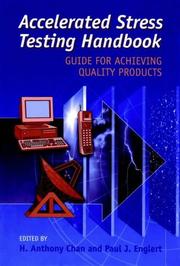| Listing 1 - 10 of 27 | << page >> |
Sort by
|
Book
ISBN: 0738187526 Year: 2013 Publisher: New York : IEEE,
Abstract | Keywords | Export | Availability | Bookmark
 Loading...
Loading...Choose an application
- Reference Manager
- EndNote
- RefWorks (Direct export to RefWorks)
Environmental testing requirements are defined for communications networking devices to be installed in transmission and distribution facilities. This standard establishes a common reproducible basis for designing and evaluating devices utilizing radio frequency (RF) up to 6 GHz, power line communications, and broadband over power line (BPL) technologies. It also requires immunity to five IEC electromagnetic compatibility standards for which there are no IEEE equivalent standards. This standard is an extension to IEEE Std 1613-2009 and IEEE Std 1613a-2011. Keywords: common-mode disturbances, communications networking device, conducted RF, damped oscillatory magnetic fields, IEEE 1613.1, immunity, power frequency magnetic fields, radiated, RFI hazards, surge.
Book
ISBN: 0878499830 Year: 2006 Publisher: Zürich Trans tech publ.
Abstract | Keywords | Export | Availability | Bookmark
 Loading...
Loading...Choose an application
- Reference Manager
- EndNote
- RefWorks (Direct export to RefWorks)
Concrete --- Corrosion --- Environmental testing
Periodical
Abstract | Keywords | Export | Availability | Bookmark
 Loading...
Loading...Choose an application
- Reference Manager
- EndNote
- RefWorks (Direct export to RefWorks)
Book
ISBN: 085274188X Year: 1971 Publisher: London, : Adam Hilger,
Abstract | Keywords | Export | Availability | Bookmark
 Loading...
Loading...Choose an application
- Reference Manager
- EndNote
- RefWorks (Direct export to RefWorks)
Electric measurements --- Electronic instruments --- Environmental testing --- Physical measurements
Book
Year: 1969 Publisher: Washington, D.C. : National Aeronautics and Space Administration,
Abstract | Keywords | Export | Availability | Bookmark
 Loading...
Loading...Choose an application
- Reference Manager
- EndNote
- RefWorks (Direct export to RefWorks)
Aluminum alloys --- Supersonic transport planes --- Ductility. --- Creep. --- Materials --- Environmental testing.
Book
Year: 1969 Publisher: Washington, D.C. : National Aeronautics and Space Administration,
Abstract | Keywords | Export | Availability | Bookmark
 Loading...
Loading...Choose an application
- Reference Manager
- EndNote
- RefWorks (Direct export to RefWorks)
Aluminum --- Deformations (Mechanics) --- Mechanical wear. --- Surfaces. --- Embrittlement. --- Environmental testing.
Book
ISSN: 03796566 ISBN: 9290920580 9789290920588 Year: 1990 Volume: 304 Publisher: Paris ESA
Abstract | Keywords | Export | Availability | Bookmark
 Loading...
Loading...Choose an application
- Reference Manager
- EndNote
- RefWorks (Direct export to RefWorks)
Space vehicles --- Space environment --- Equipment and supplies --- Environmental testing --- Congresses --- Materials --- -Space vehicles --- -Space environment --- -Environment, Space --- Extraterrestrial environment --- Space weather --- Extreme environments --- Space rockets --- Spacecraft --- Spaceships --- Astronautics --- Navigation (Astronautics) --- Rocketry --- Vehicles --- -Environmental testing --- -Congresses --- -Equipment and supplies --- Equipment and supplies&delete& --- Environmental testing&delete& --- Materials&delete& --- Space vehicles - Equipment and supplies - Environmental testing - Congresses --- Space vehicles - Materials - Environmental testing - Congresses --- Space environment - Congresses
Periodical
Year: 1988 Publisher: [Bury Saint Edmunds, England] : [Published for the Society by Mechanical Engineering Pub.]
Abstract | Keywords | Export | Availability | Bookmark
 Loading...
Loading...Choose an application
- Reference Manager
- EndNote
- RefWorks (Direct export to RefWorks)
Buildings --- Environmental engineering --- Environmental testing --- Materials --- Engineering. --- Environment. --- Materials Testing. --- Environmental Engineering. --- Environmental engineering. --- Environmental testing. --- Testing --- Testing. --- Constructions --- Technique de l'environnement --- Essais d'environnement --- Matériaux --- Essais
Periodical
Year: 1988 Publisher: [Bury Saint Edmunds, England] : [Published for the Society by Mechanical Engineering Pub.]
Abstract | Keywords | Export | Availability | Bookmark
 Loading...
Loading...Choose an application
- Reference Manager
- EndNote
- RefWorks (Direct export to RefWorks)
Buildings --- Environmental engineering --- Environmental testing --- Materials --- Engineering. --- Environment. --- Materials Testing. --- Environmental Engineering. --- Environmental engineering. --- Environmental testing. --- Testing --- Testing. --- Constructions --- Technique de l'environnement --- Essais d'environnement --- Matériaux --- Essais

ISBN: 0780360257 0470544058 9780470544051 9780780360259 Year: 2001 Publisher: New York [Piscataqay, New Jersey] IEEE Press IEEE Xplore
Abstract | Keywords | Export | Availability | Bookmark
 Loading...
Loading...Choose an application
- Reference Manager
- EndNote
- RefWorks (Direct export to RefWorks)
As we move closer to a genuinely global economy, the pressure to develop highly reliable products on ever-tighter schedules will increase. Part of a designer's "toolbox" for achieving product reliability in a compressed time frame should be a set of best practices for utilizing accelerated stress testing (AST). The Accelerated Stress Testing Handbook delineates a core set of AST practices as part of an overall methodology for enhancing hardware product reliability. The techniques presented will teach readers to identify design deficiencies and problems with component quality or manufacturing processes early in the product's life, and then to take corrective action as quickly as possible. A wide array of case studies gleaned from leading practitioners of AST supplement the theory and methodology, which will provide the reader with a more concrete idea of how AST truly enhances quality in a reduced time frame. Important topics covered include: . Theoretical basis for AST. General AST best practices. AST design and manufacturing processes. AST equipment and techniques. AST process safety qualification In this handbook, AST cases studies demonstrate thermal, vibration, electrical, and liquid stress application; failure mode analysis; and corrective action techniques. Individuals who would be interested in this book include: reliability engineers and researchers, mechanical and electrical engineers, those involved with all facets of electronics and telecommunications product design and manufacturing, and people responsible for implementing quality and process improvement programs.
| Listing 1 - 10 of 27 | << page >> |
Sort by
|

 Search
Search Feedback
Feedback About UniCat
About UniCat  Help
Help News
News